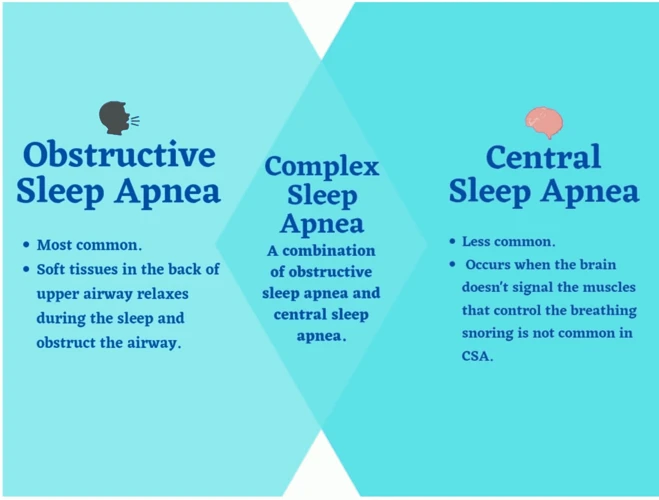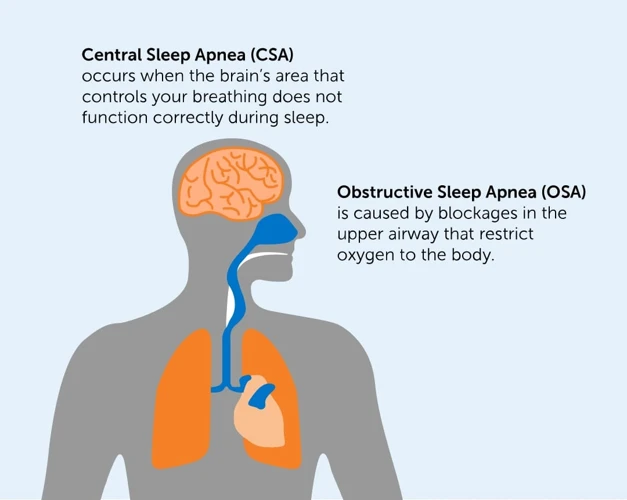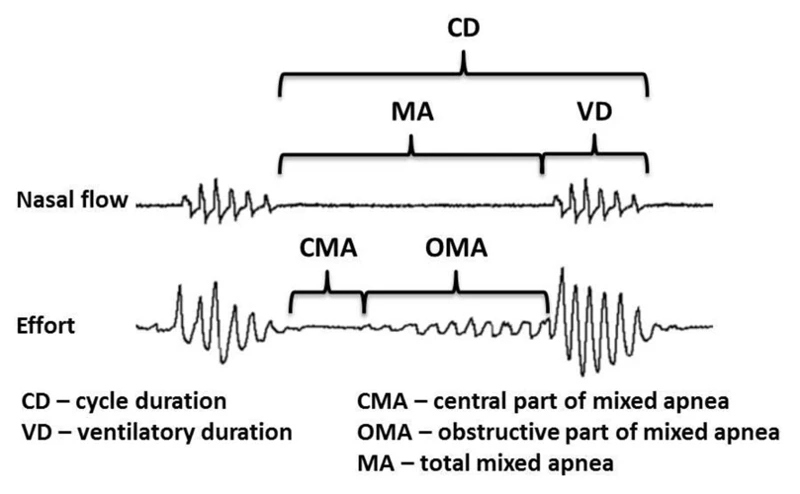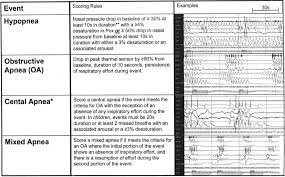For many people, getting a full night’s sleep is a luxury. However, for those who suffer from sleep apnea, getting restful sleep can be nearly impossible. Sleep apnea is a common yet serious disorder that affects millions of people worldwide. It can cause a range of health problems from high blood pressure to heart disease. There are two main types of sleep apnea, obstructive and central, both of which can impact a person’s quality of life. In this article, we delve into the basics of sleep apnea and its types, and explore the causes, symptoms, and treatments for each type.
The Basics of Sleep Apnea

Sleep apnea is a common yet often undiagnosed sleep disorder that affects millions of people worldwide. It can be characterized by frequent interruptions to breathing during sleep, leading to poor sleep quality and a range of health complications. Understanding the basics of sleep apnea, including its types and symptoms, is crucial for early detection and proper treatment. Let’s delve deeper into the key aspects of this sleep disorder.
What is Sleep Apnea?
Sleep apnea is a sleep disorder that affects an estimated 22 million Americans. However, many people may not even realize they have this condition, as it often goes undiagnosed. Essentially, sleep apnea is characterized by interruptions in breathing during sleep. These brief pauses in breathing can last anywhere from a few seconds to a few minutes and can occur repeatedly throughout the night. This can lead to a range of health problems, since your body isn’t getting enough oxygen.
Here are some key points to remember:
- Sleep apnea can cause brief pauses in breathing during sleep
- These pauses can last from a few seconds to a few minutes.
- Sleep apnea can go undiagnosed
- It can lead to health problems because the body isn’t getting enough oxygen
There are two main types of sleep apnea: obstructive sleep apnea (OSA) and central sleep apnea (CSA). OSA is caused by a physical obstruction in the airway, while CSA occurs when the brain does not send the proper signals to the muscles that control breathing. Both types of sleep apnea can have serious health consequences if left untreated. It’s important to recognize the symptoms of sleep apnea so that you can seek the appropriate treatment.
Types of Sleep Apnea
Sleep apnea is a common disorder that severely affects sleep quality, health, and life expectancy. There are two main types of sleep apnea – Obstructive Sleep Apnea (OSA) and Central Sleep Apnea (CSA), both of which are characterized by breath interruptions during sleep. Here’s a look at the basic differences between the two:
| Type of Sleep Apnea | Definition | Cause |
|---|---|---|
| Obstructive Sleep Apnea (OSA) | Occurs when the muscles in the back of the throat fail to keep the airway open, despite effort to breathe. | Obesity, blocked or narrowed airways, large tonsils or tongue, aging, and other medical conditions. |
| Central Sleep Apnea (CSA) | Occurs when the brain fails to send proper signals to the muscles that control breathing. | Damage to the brainstem, heart failure, and some medications. |
Sleep apnea, if left untreated, can lead to several complications, including high blood pressure, heart disease, stroke, depression, and diabetes. Recognizing the symptoms and seeking proper treatment is crucial in managing sleep apnea and its associated risks.
Obstructive Sleep Apnea

Sleep apnea is a serious condition that affects millions of people around the world. It is characterized by interruptions in breathing during sleep, which can lead to a range of health problems, including high blood pressure, heart disease, and stroke. One of the most common types of sleep apnea is obstructive sleep apnea, which occurs when the airway becomes blocked during sleep. This can result in loud snoring, pauses in breathing, and restless sleep. In this section, we will explore the causes, symptoms, and treatments for obstructive sleep apnea.
What causes Obstructive Sleep Apnea?
Obstructive Sleep Apnea occurs when the muscles in the back of the throat fail to keep the airway open, thereby causing breathing to stop and start repeatedly throughout the night. There are several factors that can cause the muscles to relax and obstruct the airway, including:
- Excessive weight: People who are overweight have an increased risk of developing Obstructive Sleep Apnea since excess fat around the neck can constrict the airway.
- Anatomical abnormalities: Physical characteristics that narrow the airway can also contribute to the development of Sleep Apnea. This includes enlarged tonsils, a small jawbone, or a recessed chin.
- Smoking and alcohol consumption: Smoking damages the airway’s lining, making it more prone to collapse. Similarly, alcohol can cause the muscles in the throat to relax excessively, which can increase the risk of obstruction.
- Nasal congestion: People with chronic nasal congestion or allergies may be at greater risk of Obstructive Sleep Apnea since it can make it difficult to breathe through the nose, forcing the individual to breathe through their mouth, and making them more susceptible to airway obstruction.
- Aging: As people age, the muscles in the throat can naturally relax, making them more susceptible to Obstructive Sleep Apnea.
It’s essential to address these underlying causes of Obstructive Sleep Apnea to prevent the risk of developing the condition. Fortunately, lifestyle changes, such as weight loss, smoking cessation, and limiting alcohol intake, and medical interventions, such as the use of continuous positive airway pressure (CPAP) machines, can help alleviate the symptoms and improve sleep quality.
Symptoms of Obstructive Sleep Apnea
Obstructive Sleep Apnea causes a variety of symptoms that can negatively impact a person’s overall health and quality of life. Some common symptoms of Obstructive Sleep Apnea include:
| Symptom | Description |
|---|---|
| Loud snoring | One of the most common symptoms of Obstructive Sleep Apnea is loud, chronic snoring. This is caused by the vibrations of the soft tissue in the throat. |
| Gasping or choking during sleep | As the airway becomes blocked, a person may gasp or choke for air during their sleep. This can be a frightening experience. |
| Excessive daytime sleepiness | Due to frequent awakenings during the night, a person with Obstructive Sleep Apnea may experience excessive daytime sleepiness, even after a full night’s rest. |
| Frequent awakenings during the night | As the airway becomes blocked and breathing stops, a person with Obstructive Sleep Apnea may wake up several times throughout the night. This can lead to restless sleep and feelings of exhaustion during the day. |
| Difficulty concentrating and memory problems | Due to the lack of restful sleep, a person with Obstructive Sleep Apnea may experience difficulty with concentration and memory, making everyday tasks more difficult to complete. |
| Irritability and mood swings | As a result of the sleep disturbances and exhaustion, a person with Obstructive Sleep Apnea may experience irritability and mood swings, which can negatively impact personal and professional relationships. |
If you or someone you know is experiencing any of these symptoms, it’s important to speak with a healthcare provider about the possibility of Obstructive Sleep Apnea.
Treatment for Obstructive Sleep Apnea
The gold standard treatment for obstructive sleep apnea (OSA) is continuous positive airway pressure (CPAP) therapy. CPAP works by delivering a steady stream of air through a mask that is worn over the nose or the mouth during sleep. The air pressure keeps the airways open, preventing them from collapsing and causing breathing pauses.
However, many people find CPAP therapy to be uncomfortable and cumbersome, and may not use it consistently as a result. In these cases, there are alternative treatments that can be considered.
Oral appliances can be used to treat mild to moderate OSA by repositioning the jaw during sleep, which helps to keep the airway open. These devices are custom-fitted by a dentist or orthodontist.
Surgery may also be an option for certain individuals with OSA, particularly for those with anatomical abnormalities or structural issues that contribute to airway obstruction. Surgical options range from minimally invasive procedures to more extensive surgeries that involve removing or repositioning tissue in the throat or mouth.
Finally, lifestyle modifications such as weight loss, reducing alcohol consumption, and avoiding sleeping on one’s back can help to alleviate OSA symptoms.
It is important for individuals with OSA to consult with a healthcare professional to determine the best course of treatment for their specific case. A combination of treatments may be necessary to effectively manage the condition.
| Treatment Options for OSA | Description |
|---|---|
| Continuous Positive Airway Pressure (CPAP) | Delivers a steady stream of air through a mask worn over the nose or mouth to keep the airway open. |
| Oral Appliances | Custom-fitted devices that reposition the jaw to keep the airway open during sleep. |
| Surgery | Minimally invasive or extensive procedures to remove or reposition tissue in the throat or mouth to alleviate airway obstruction. |
| Lifestyle Modifications | Weight loss, reducing alcohol consumption, and avoiding sleeping on one’s back can help alleviate OSA symptoms. |
Central Sleep Apnea

Sleep apnea can be a perplexing and challenging condition that affects people’s sleep quality and overall health. While obstructive sleep apnea is the most common type, central sleep apnea is less well understood and less frequently diagnosed. In this section, we will explore the basics of central sleep apnea, including its causes, symptoms, and treatment options to better understand this lesser-known form of sleep apnea.
What causes Central Sleep Apnea?
Central Sleep Apnea (CSA) is caused by the failure of the brain in controlling breathing during sleeping. It can be triggered by different reasons, such as:
- Damage to the brainstem: The brainstem is responsible for controlling vital body functions such as breathing, heart rate, and blood pressure. Injuries, tumors, or diseases that affect the brainstem can lead to CSA.
- Heart failure: People with heart failure have an increased risk of developing CSA. The reduced pumping ability of the heart can cause fluid buildup in the lungs, leading to breathing difficulties.
- Certain medications: Some medications such as opioids, benzodiazepines, and barbiturates can suppress breathing and lead to CSA.
- High altitude: Traveling to high altitudes can decrease the amount of oxygen in the air and cause CSA.
- Nervous system disorders: Neurological disorders such as Parkinson’s disease, Multiple Sclerosis, and Amyotrophic Lateral Sclerosis (ALS) can damage the brain and spinal cord, leading to CSA.
It is important to identify the underlying cause of CSA to determine the best treatment approach. Treatment may involve addressing the underlying health condition or using a positive airway pressure device to help regulate breathing during sleep.
Symptoms of Central Sleep Apnea
Central Sleep Apnea (CSA) is a type of sleep apnea that occurs when the brain fails to send proper signals to the respiratory muscles. The symptoms of CSA can be very similar to Obstructive Sleep Apnea (OSA), but their cause and treatment can vary significantly.
The following table highlights some of the common symptoms associated with Central Sleep Apnea:
| Symptom | Description |
| Excessive daytime sleepiness | Feeling highly fatigued and excessively sleepy during the day, resulting in difficulty concentrating during normal activities or feeling a strong urge to nap. |
| Difficulty staying asleep | Having trouble staying asleep during the night due to sleep disturbances or episodes of breathing cessation, leading to frequent awakenings and interruptions in the sleep cycle. |
| Shortness of breath | Experiencing shortness of breath or a sensation of being unable to catch one’s breath, often during sleep or after awakening from sleep. |
| Frequent awakenings during the night | Waking up multiple times during the night, often feeling like a jolt or feeling panicked, leaving the person feeling groggy upon awakening. |
| Problems with memory and concentration | Experiencing difficulty with memory and concentration, often leading to forgetfulness or trouble with simple tasks, such as remembering appointments. |
It is essential to note that CSA symptoms can be similar to other sleep disorders, which is why it’s vital to seek professional medical help to identify the exact cause of someone’s symptoms. The symptoms can also change over time, and it’s essential to keep track of these changes and report them to a medical professional regularly.
Treatment for Central Sleep Apnea
Central sleep apnea is a complex condition that requires proper medical treatment. Individuals who suffer from central sleep apnea should seek medical attention for appropriate diagnosis and treatment. Here are some common treatments for central sleep apnea:
- Positive Airway Pressure (PAP): PAP machines are most commonly used to treat obstructive sleep apnea. However, they can also be used to treat central sleep apnea. This machine delivers air pressure to keep the airways open during sleep, ensuring proper breathing.
- Oxygen Therapy: In some cases, supplemental oxygen may be given to individuals with central sleep apnea. This helps to maintain normal oxygen levels in the blood during periods of interrupted breathing.
- Medications: Certain medications can be prescribed to individuals with central sleep apnea, depending on the cause of the condition. For example, if central sleep apnea is caused by heart failure, medications that target the heart condition may be prescribed.
- Ventilatory Support: This treatment involves using a device that supports breathing, such as a BiPAP machine that delivers two levels of pressure to assist with breathing.
- Lifestyle Changes: Addressing underlying medical conditions like obesity and heart disease, avoiding sedatives and alcohol, and quitting smoking can help improve central sleep apnea symptoms.
It is important to note that treatment options for central sleep apnea may vary from person to person depending on the severity and underlying causes of the condition. It is essential to consult a healthcare provider for an accurate diagnosis and to develop an effective treatment plan for central sleep apnea.
Differences between Obstructive and Central Sleep Apnea
As we have learned, there are two main types of sleep apnea – obstructive sleep apnea and central sleep apnea. While both types can cause disrupted sleep and lead to serious health issues if not treated, their underlying causes and mechanisms of airflow differ. In this section, we will explore the differences between these two types of sleep apnea in detail, including their causes, symptoms, and treatment options. It’s important to understand the distinctions between them, as the treatment approaches can vary depending on the type of sleep apnea a person has.
Mechanism of Airflow
The mechanism of airflow is a crucial difference between Obstructive Sleep Apnea (OSA) and Central Sleep Apnea (CSA). In OSA, the airflow is hindered by physical obstructions, while in CSA, the issue is a neurological malfunction.
In Obstructive Sleep Apnea:
| Mechanism of Airflow: | Description: |
|---|---|
| Obstruction | The muscles at the back of the throat fail to keep the airway open during sleep, causing a blockage in the airflow |
In Central Sleep Apnea:
| Mechanism of Airflow: | Description: |
|---|---|
| Neurological Issue | The brain fails to send the proper signals to the muscles that control breathing, resulting in a pause in breathing |
The difference in airflow mechanism is what makes the two types of sleep apnea distinct. In OSA, the blockage in airflow creates loud snoring and can lead to frequent waking up during sleep. In CSA, the pause in breathing happens repeatedly, causing a shallow sleep that may lead to daytime fatigue and sleepiness.
Causes
The causes of obstructive sleep apnea and central sleep apnea are different.
Causes of Obstructive Sleep Apnea:
- Excess weight or obesity, which can narrow the airways and make it harder to breathe
- Enlarged adenoids or tonsils
- Physical abnormalities in the nose, throat, or airway that can obstruct the airflow during sleep
- Smoking or exposure to secondhand smoke, which can irritate the airways and lead to inflammation and swelling
- Alcohol consumption, which can relax the muscles in the throat and interfere with the breathing process
- Use of sedatives or sleeping pills, which can also relax the muscles in the throat and interfere with breathing
- Family history of sleep apnea
Causes of Central Sleep Apnea:
- Heart problems, such as congestive heart failure, atrial fibrillation, or stroke, which can interfere with the brain’s ability to control breathing during sleep
- Neurological disorders, such as Parkinson’s disease, Alzheimer’s disease, or multiple sclerosis, which can affect the respiratory muscles and respiratory drive
- High altitude, which can lower the oxygen levels in the blood and make breathing more difficult
- Use of certain medications, such as opioids, which can interfere with the brain’s control of breathing
- Obesity, which can contribute to the development of central sleep apnea as well as obstructive sleep apnea
- CPAP or BiPAP therapy for obstructive sleep apnea, which can sometimes lead to central sleep apnea
It is important to note that some individuals may have both obstructive and central sleep apnea, which is known as complex sleep apnea syndrome. In such cases, a thorough evaluation by a healthcare professional is necessary to determine the underlying causes and appropriate treatment options.
Symptoms
Symptoms of Obstructive and Central Sleep Apnea-
| Obstructive Sleep Apnea (OSA) | Central Sleep Apnea (CSA) |
| – Loud snoring | – Snoring is rare |
| – Gasping or choking during sleep | – Frequent awakenings |
| – Difficulty staying asleep | – Daytime sleepiness |
| – Morning headache | – Shortness of breath during sleep |
| – Dry mouth or sore throat upon awakening | – Difficulty initiating sleep |
| – Daytime sleepiness | – Insomnia |
People with OSA may experience loud snoring, gasping or choking during sleep, difficulty staying asleep, morning headaches, dry mouth or sore throat upon awakening, and daytime sleepiness. On the other hand, people with CSA may experience snoring less frequently, frequent awakenings, daytime sleepiness, shortness of breath during sleep, difficulty initiating sleep, and insomnia. It is important to note that some symptoms may overlap between the two types of sleep apnea, and a proper diagnosis should be made by a healthcare professional.
Treatments
Treatment for Obstructive Sleep Apnea and Central Sleep Apnea differs based on the type and severity of the condition.
Treatment for Obstructive Sleep Apnea:
There are several treatment options available for Obstructive Sleep Apnea. The most common treatments include:
| Treatment | Description |
|---|---|
| Continuous Positive Airway Pressure (CPAP) | A CPAP machine delivers constant air pressure to the airways preventing them from collapsing during sleep. |
| Bi-level Positive Airway Pressure (BiPAP) | A BiPAP machine delivers different air pressures during inspiration and expiration. |
| Oral Appliances | Oral appliances like mandibular advancement devices can be used to open the airway by moving the lower jaw forward during sleep. |
| Surgery | Surgery can be helpful in some cases where there is a structural abnormality causing obstruction of the airway. It involves removing excess tissue from the airway or correcting abnormalities in the jaw or throat. |
| Lifestyle Changes | Lifestyle changes like weight loss, exercising regularly, avoiding alcohol and smoking can help in reducing the severity of OSA. |
Treatment for Central Sleep Apnea:
The primary treatment for Central Sleep Apnea is treating the underlying medical condition causing the breathing disturbances. The most common treatments include:
| Treatment | Description |
|---|---|
| Continuous Positive Airway Pressure (CPAP) | CPAP can also be helpful in improving the sleep quality of people with Central Sleep Apnea. |
| Oxygen Therapy | People with severe Central Sleep Apnea may require supplemental oxygen therapy during sleep. |
| Medications | Medications like acetazolamide can stimulate breathing and help in improving the symptoms of CSA. |
| Bilevel or Adaptive Servo-Ventilation | Bilevel or Adaptive Servo-Ventilation devices can improve breathing and sleep quality in people with CSA. |
| Lifestyle Changes | Lifestyle changes like avoiding alcohol and smoking, sleeping in a slightly elevated position, and maintaining a regular sleep schedule can also improve the symptoms of CSA. |
It is important to note that self-treatment is not recommended for either type of Sleep Apnea, and a proper diagnosis and treatment plan should be determined by a healthcare professional specializing in Sleep Medicine.
Conclusion
After learning about the two main types of sleep apnea, obstructive and central, it becomes clear that they have distinct differences in both causes and treatment. Obstructive sleep apnea is caused by a physical obstruction of the airway, while central sleep apnea is caused by a failure of the brain to properly control breathing during sleep.
The symptoms of these two types of sleep apnea may overlap, but subtle differences can help guide diagnosis and treatment. Those experiencing loud snoring, gasping for air during sleep, and feeling tired despite a full night’s sleep may have obstructive sleep apnea. Those experiencing pauses in breathing followed by sudden awakenings and shortness of breath may have central sleep apnea.
Treatment for both types of sleep apnea may include lifestyle changes such as losing weight or quitting smoking, as well as the use of continuous positive airway pressure (CPAP) machines. However, central sleep apnea may also require treatment for underlying health conditions such as heart failure or strokes that may be causing the breathing issues.
Overall, understanding the differences between obstructive and central sleep apnea is key in diagnosing and treating the condition effectively. If left untreated, sleep apnea can lead to serious health consequences such as high blood pressure, heart disease, and stroke. Therefore, seeking medical advice and pursuing treatment options is crucial for those experiencing symptoms of sleep apnea.
Frequently Asked Questions
Sleep apnea is a sleep disorder where a person experiences pauses in breathing or shallow breaths during sleep, disrupting their normal sleep cycle.
What are the two types of Sleep Apnea?
The two types of Sleep Apnea are Obstructive Sleep Apnea and Central Sleep Apnea.
Obstructive Sleep Apnea is caused by blocked airways due to relaxed throat muscles or other physical obstructions that disrupt the normal airflow during sleep.
What are the symptoms of Obstructive Sleep Apnea?
The symptoms of Obstructive Sleep Apnea include snoring, frequent waking up at night, daytime fatigue, sore throat, dry mouth, headache, and difficulty concentrating.
What is the treatment for Obstructive Sleep Apnea?
Treatment for Obstructive Sleep Apnea may include lifestyle changes, such as losing weight or avoiding alcohol before bedtime, using a Continuous Positive Airway Pressure (CPAP) device, or surgery to remove obstructions.
Central Sleep Apnea is caused by a failure of the brain to send proper signals to the muscles that control breathing during sleep.
What are the symptoms of Central Sleep Apnea?
The symptoms of Central Sleep Apnea include pauses in breathing during sleep, frequent waking up at night, daytime fatigue, and difficulty concentrating.
What is the treatment for Central Sleep Apnea?
Treatment for Central Sleep Apnea may include addressing underlying medical conditions, using a Bi-level Positive Airway Pressure (BiPAP) device, or medication to stimulate the respiratory system.
What is the difference between Obstructive and Central Sleep Apnea?
The main difference between Obstructive and Central Sleep Apnea is the mechanism of airflow during sleep. Obstructive Sleep Apnea is caused by blocked airways, while Central Sleep Apnea is caused by a failure of the brain to signal proper breathing.
Can untreated Sleep Apnea lead to other health problems?
Yes, untreated Sleep Apnea can lead to other health problems such as high blood pressure, heart disease, stroke, and diabetes.
How can Sleep Apnea be prevented?
Sleep Apnea can be prevented by maintaining a healthy weight, avoiding smoking and alcohol, sleeping on your side, and seeking medical treatment for underlying medical conditions that may cause or worsen the condition.








